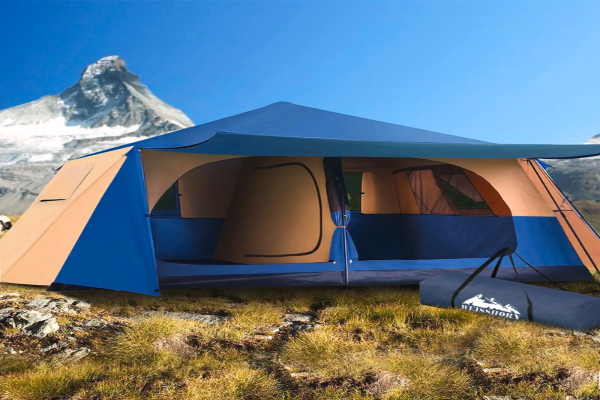When choosing a tent for outdoor adventures, one of the most critical features to consider is its waterproofing. A tent’s waterproof rating is often measured in millimeters (mm) of water column height, which indicates how much water pressure the fabric can withstand before leaking. In this article, we will explore what a 3000mm waterproof rating means, the factors affecting waterproofness, and practical tips for choosing and maintaining your tent.
Understanding Waterproof Ratings
Waterproof ratings are essential for assessing how well a tent can protect you from rain and moisture. The rating is determined by placing a column of water on the fabric until it begins to leak. Here’s how the ratings generally break down:
Below 1000mm: Not waterproof. Suitable for light dew or mist.
1000mm – 2000mm: Water-resistant. Can handle light rain but may leak in heavier downpours.
2000mm – 3000mm: Waterproof. Suitable for moderate rain.
Above 3000mm: Highly waterproof. Designed for heavy rain and wet conditions.
With a rating of 3000mm, a tent is considered to be waterproof enough for most outdoor activities, including camping in wet weather.
SEE ALSO: Best Folding Chairs 2024
What Does 3000mm Mean?
A 3000mm rating means that the tent fabric can withstand a column of water that is 3000mm high before water begins to seep through. This level of waterproofing is generally adequate for the following conditions:
Moderate Rain: Ideal for camping trips where rain is expected but not torrential downpours.
Snow: Can handle light to moderate snow accumulation without leaking.
Condensation: Offers some protection against moisture from the ground and air, although proper ventilation is still necessary to manage condensation.
Factors Affecting Waterproofness
1. Fabric Material
The material used in the tent plays a significant role in its waterproof capabilities. Common materials include:
Polyester: Lightweight and resistant to UV rays, making it a popular choice. Generally, polyester tents have good waterproof ratings.
Nylon: Often stronger and lighter than polyester, nylon tents usually have better waterproofing when treated properly.
Ripstop Fabric: A reinforced material that prevents tearing and enhances durability, often used in high-quality tents.
2. Coatings
Most tents come with a waterproof coating, such as polyurethane (PU) or silicone. Here’s how they impact waterproofing:
PU Coating: Common in many tents, PU coatings can provide excellent waterproofing. Tents with this coating often require a higher rating to be effective.
Silicone Coating: Usually found on higher-end tents, silicone coatings are more durable and maintain waterproofing for longer.
3. Seams and Stitching
Seam construction is crucial in maintaining waterproofness. Tents with taped or welded seams provide better protection against water ingress. Here’s what to look for:
Taped Seams: A waterproof tape is applied over the stitched seams to prevent leaks.
Welded Seams: Fabric pieces are fused together, eliminating needle holes and reducing leak potential.
4. Tent Design
The design of the tent can influence its ability to shed water effectively. Key features include:
Rainfly: An outer layer that extends over the tent, providing an additional barrier against rain. A good rainfly is essential for wet conditions.
Ventilation: Proper ventilation helps reduce condensation inside the tent, which can lead to water pooling on the fabric.
Pros and Cons of 3000mm Waterproof Tents
Pros
Good Protection: A 3000mm tent provides reliable protection against moderate rain, making it suitable for most camping scenarios.
Versatile Use: Ideal for various outdoor activities, including hiking and backpacking, where weight and space are essential.
Affordability: Tents with a 3000mm rating are often more affordable than higher-rated options while still offering adequate waterproofing.
Cons
Limitations in Heavy Rain: While a 3000mm rating is suitable for moderate rain, it may not be enough in heavy downpours or extreme weather conditions.
Wear and Tear: Over time, the waterproof coating can wear off, requiring re-treatment or maintenance to maintain waterproofness.
Choosing the Right Tent for Your Needs
When selecting a tent, consider the following factors:
1. Climate and Conditions
Think about the weather conditions you will encounter. If you frequently camp in areas with heavy rain or snow, you might want a tent with a higher waterproof rating. For moderate climates, a 3000mm tent should suffice.
2. Tent Usage
Consider how you will use the tent. For casual camping trips, a 3000mm tent can be perfect. However, for extended trips in wet conditions, investing in a tent with a higher rating may be wise.
3. Weight and Portability
If you’re hiking or backpacking, consider the weight of the tent. A 3000mm tent is often lighter than those with higher ratings, making it easier to carry.
4. Budget
Balance your budget with the features you need. A 3000mm tent is often an affordable option that offers good performance for the price.
Maintaining Your 3000mm Tent
To ensure your tent remains waterproof, follow these maintenance tips:
1. Regular Cleaning
Keep your tent clean by gently washing it with mild soap and water. Avoid harsh detergents that can break down waterproof coatings.
2. Reapply Waterproofing
Over time, the waterproof coating can wear off. Use a waterproofing spray or treatment designed for tents to reapply protection as needed.
3. Proper Storage
Store your tent in a cool, dry place. Avoid folding it when wet, as moisture can lead to mold and mildew.
4. Inspect for Damage
Regularly check your tent for any tears or damage. Repair any issues promptly to maintain waterproofing and overall integrity.
Conclusion
A 3000mm waterproof tent offers reliable protection for most camping conditions, especially in moderate rain and snow. By understanding the waterproof rating system and considering factors like fabric material, coatings, seams, and design, you can make an informed decision when purchasing a tent. Proper maintenance and care will ensure your tent remains effective for years to come. Whether you’re embarking on a weekend camping trip or a longer outdoor adventure, a 3000mm tent can be a practical choice that balances waterproofing and portability.
Related topics:
- Best Folding Camp Chairs 2024
- Best New Camping Gear 2024: Cooking Equipment
- The 5 Best Camping Stoves 2024

